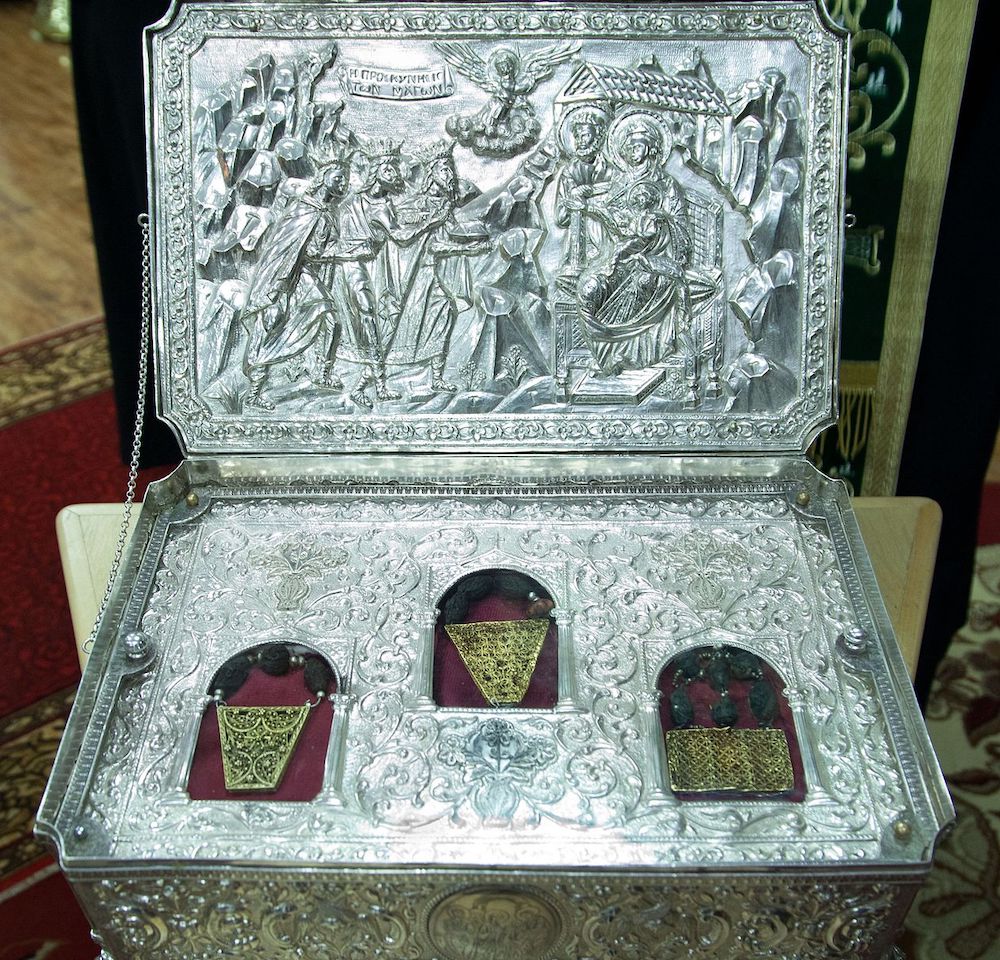
Among the innumerable treasures and holy relics preserved at the Holy Monastery of St. Paul on Mt. Athos (in Greek Άγιον Όρος, meaning “Holy Mountain”) one of the most precious, and invaluable to Greek Orthodoxy, are the Holy Gifts that are believed to have been offered by the Three Wise Men, also known as the Three Kings or the Magi, of the East to the newborn Jesus.
Their gift of gold is in the form of twenty-eight painstakingly-carved flat tiles of various shapes (rectangular, trapezoidal, polygonal, etc.) which are about 5 cm x 7 cm (2 X 3 inches) in size. Each tile has a different artistic design.
The precious gifts of frankincense and myrrh are preserved as a mixture in the form of sixty-two small, olive-sized spherical beads.
The Three Gifts of the Three Kings have great spiritual meanings: the gold was a symbol of kingship on earth, the frankincense (a type of incense) symbolized the Godhead, and the myrrh (used as an embalming oil) was a symbol of death — foretelling the death of Christ.
Are the Three Gifts of the Three Kings housed on Mt. Athos authentic?
Since the spiritual, material, historical and archaeological value of the holy gifts is incalculable, they are carefully guarded in the treasury of the monastery.
For security reasons, they are distributed only in the form of various relics, only some of which are exhibited to visitors of St. Paul Monastery or occasionally transported for viewing to various metropolises outside of Mount Athos.
The authenticity of the gifts of the Three Kings is partly based on oral tradition and the rest on history. But what confirms the authenticity of the Holy Gifts most powerfully is the unmistakable fragrance they have repeatedly imparted — and their healing and miraculous powers are still potent to this day, according to Orthodox authorities.
The story of the transportation of the Holy Gifts – which are miraculously preserved to this day – to the Holy Monastery of St. Paul on Mt. Athos is truly fascinating.
The story of the Three Kings
The Apostle Luke, known as “The Evangelist,” writes of the Virgin Mary, or Panagia, that she “kept all these words in her heart” (Luke 2:19, 51). Based on theological studies, it is believed that many of these “words,” which comprise the teachings and events of the life of Jesus Christ, were passed on by the Theotokos to Luke, who of course included them in his Gospel.
Doubtless, along with the holy “words” of Christ, His Mother would have also kept everything dealing with the earthly life of the Lord, naturally including the extraordinary Holy Gifts she had received upon His birth.
According to historical and religious tradition, before her Dormition she delivered these Gifts, together with the Holy Sepulcher of Christ, and the Holy Shroud, to the Church of Jerusalem, where they remained until the year 400 AD.
At that time, Emperor Arkadios brought them to Constantinople for the appreciation of the faithful and the protection and promotion of the Queen City.
And there they remained, undisturbed, until the sack of the city by the Crusaders in 1204. Along with other holy relics, the Gifts were then brought for their safety to Nicaea in Bithynia, the temporary capital of Byzantium, where they remained for about sixty years.
With the departure of the Crusaders under Emperor Michael Paleologos, the priceless gifts were returned again to Constantinople — until its fall to the Turks in the year 1453.
After the fall of the great city the pious Princess Mara of Serbia, the Christian wife of Sultan Mourat II (1421-1451) and the stepmother of Mohamed II of Porthetou, brought them in person to the Holy Monastery of St. Paul on Mount Athos.
This monastery was well-known to her father George Brangovitch, the ruler of Serbia, who had funded the construction of the Katholikon of the monastery in honor of the holy martyr George the Trophy-Bearer.
According to Athonite tradition, as Princess Mara approached the monastery from the port, the Theotokos somehow impeded her journey to the Monastery in a supernatural way, thus preserving the ban on women stepping foot on the Holy Mountain.
The Princess quickly obeyed the Holy Mother’s wishes, delivering the Holy Gifts to the monks and fathers of Mt. Athos, who placed a cross in the very spot where the Theotokos had appeared, which remains to this day. The monument is called the “Cross of the Queen.”
The official document from the sultan with the relevant information surrounding the delivery of the Precious Gifts is preserved intact in the library of the Monastery of St. Paul on Mt. Athos.
See all the latest news from Greece and the world at Greekreporter.com. Contact our newsroom to report an update or send your story, photos and videos. Follow GR on Google News and subscribe here to our daily email!



